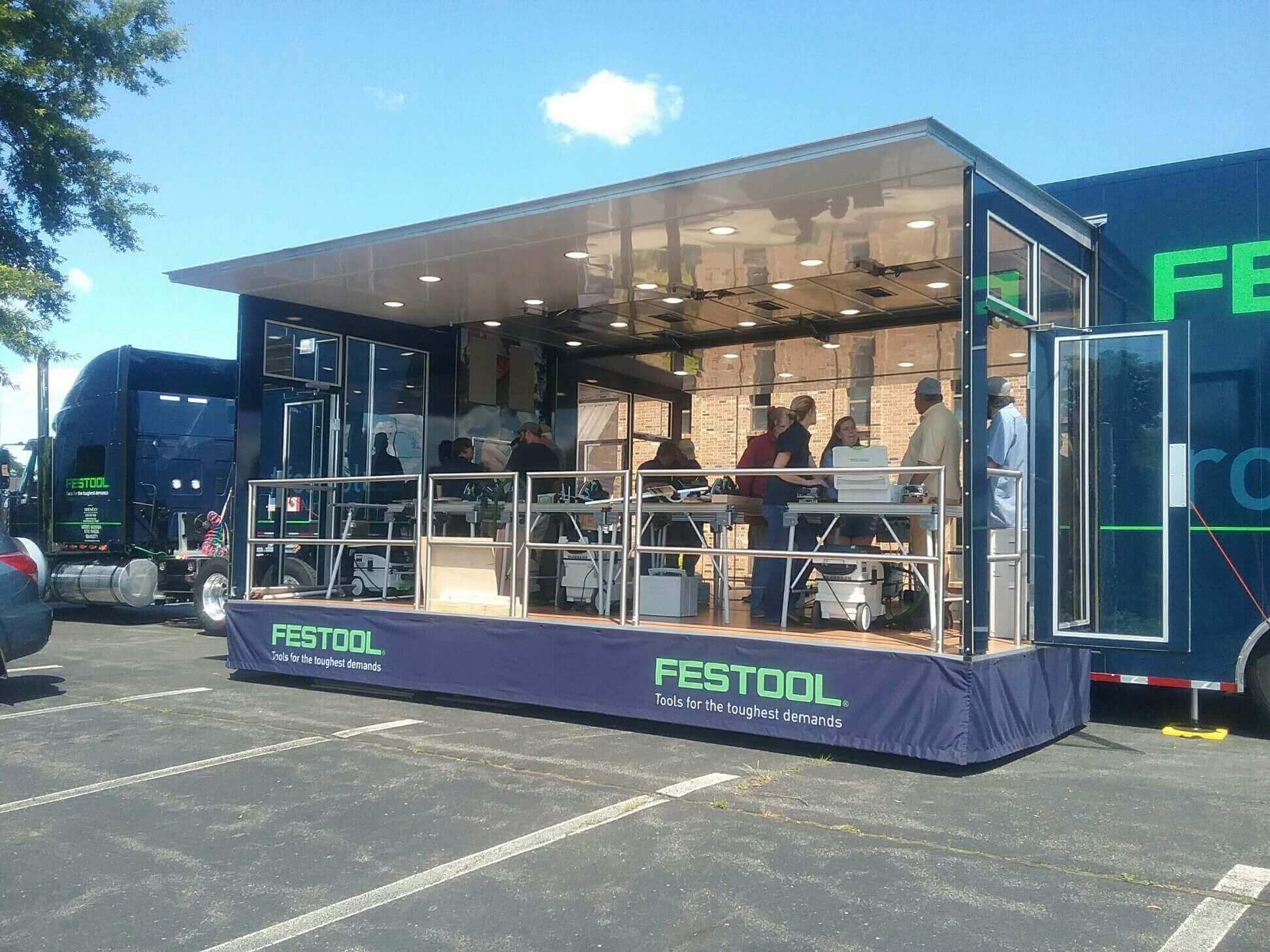In our “how to” post that details the steps that go into creating an experiential marketing vehicle, we talk about utilizing a design-build process for developing roadshows. Since this is a unique process in the mobile exhibit industry, we’re happy to explore this approach in more detail. Why? In our experience, it makes a huge difference in the efficiency and end result.
Design-Build vs Design-Bid-Build
Even though Design-Build (DB) is a popular, proven process used around the world in commercial, transportation and utility construction, it’s rare to find an experiential marketing vehicle company that uses this approach.
CALLOUT:
Design-Build is a project delivery system used in the construction industry in which the design and construction services are contracted by a single entity known as the Design-Builder.
Instead, many in the industry have stuck with a Design-Bid-Build (DBD) process. The implication here is that the Design is a phase that can be handled by one firm. Then, once a design is selected, it gets sent out to an entirely different group of companies that Bid on building the vehicle. The project gets awarded, usually to the lowest bidder, and the Build phase starts. If this sounds like a minor distinction, it’s not. Not by a long shot.
The Big DBD Problem
Time and talent. Brands and exhibit companies that rely on the DBD process have to find an agency to produce the strategy; then find an exhibit house to design an exhibit, or design the exhibit themselves; all the while managing the back and forth between all the stakeholders until all the details are worked out. Then the procurement process cranks up where the final design is shopped (formally or informally) to get the lowest bid. Then and only then can the actual build of the vehicle begin.
All of that — gathering of vendors and resources, corralling of opinions and approvals, coordinating of communication — takes time and invites far too much conversation rather than decision.
CALLOUT:
In contrast, Design-Build relies on a single point of responsibility contract and is used to minimize risks for the project owner and to reduce the delivery schedule by overlapping the design phase and construction phase of a project.
That time doesn’t come from the back end of the project – the launch date never moves – so the result is the most hastily assembled, cheapest product with the lowest quality materials that a fabricator can possibly produce in the time left over.
The Big DB Advantage
The main idea of Design-Build is the ability to overlap Design with Fabrication, creating time and cost savings where none existing before. With a single point of responsibility, the client can reduce risk and stay better informed of the project’s status at any given moment.
CALLOUT:
Design-Build is sometimes compared to the "master builder" approach, one of the oldest forms of construction procedure. Comparing design–build to the traditional method of procurement, the authors of the Design-Build Contracting Handbook noted that: “from a historical perspective the so-called traditional approach is actually a very recent concept, only being in use approximately 150 years. In contrast, the Design-Build concept—also known as the "master builder" concept—has been reported as being in use for over four millennia."[2]
Often, the single point of responsibility role for a program resides with the Brand’s agency of record. But if that agency doesn’t have tour program design experience or fabrication experience, you’ll have to look at who else can be considered for that role. Agencies working on a retainer or hourly rate typically aren’t inclined to “getting on with it” since they aren’t plugged in with production capacities and supply chains. Most campaigns require a sense of urgency throughout the design and fabrication period in order to launch on time.
With the single point of responsibility, the Brand has a clear path to transfer risk to the “Master Builder” – there can be no finger-pointing in a Design-Build Contract. We take responsibility for making the trains run on time.
The Value Gain
In the construction industry, they call it “value engineering.” In experiential marketing vehicle development, it means that when design overlaps with fabrication, the experts in fabrication inform the design process. That is, the engineers have the opportunity to propose solutions that will create value in the project before the design is even complete. It can even eliminate obstacles that the designer could not foresee and reduce delays in delivery.
CALLOUT:
Design-Build saves time and money for the owner, while providing the opportunity to achieve innovation in the delivered facility.
Design-Build brings all members of a project team together early in the process to identify and address issues of cost, schedule and constructability. Proponents suggest that as a result, design-build alleviates conflict between architects and contractors and reduces owner risk for design errors.
They argue that once design is finalized and construction begins, the greatest opportunity to achieve cost savings has already been lost, and the potential for design errors is greater, leading to change orders that create cost growth and schedule delays. Design-Build places the responsibility for design errors and omissions on the design–builder, relieving the owner of major legal and managerial responsibilities.
Value Engineering is an often overlooked piece of the strategy – from the original budget, the master builder is continually looking for ways to save money on the project and share those savings with the Brand. The shared budget approach lets the Brand, the Agency, the Fabricator, and the vendors sit on the same side of the proverbial table and work together to create best-value options.
Another overlooked yet valuable benefit is that DB allows us to reduce conflict – all parties work through the project as partners, relieving the Brand executives of the stress, responsibility, and risk of being the sole decision-maker and project coordinator.
The Bonus Savings
Last but not least, we’re talking about demonstrated savings of time and money. Both are always in short supply. The Design-Build process helps make the most of both.
CALLOUT:
The cost and schedule reduction and decreased litigation associated with Design-Build project delivery have been demonstrated repeatedly. Researches on Selecting Project Delivery Systems[15] by Victor Sanvido and Mark Konchar of Pennsylvania State University found that Design-Build projects are delivered 33.5% faster than projects that are designed and built under separate contracts (design-bid-build).
Sanvido and Konchar also showed that design–build projects are constructed 12% faster* and have a unit cost that is 6.1% lower than design-bid-build projects.
Research shows we can shave 25-35% of the duration off a project utilizing Design-Build. That’s significant when a Brand is behind schedule to roll out a new product or open a new territory. Simply agreeing on the rough structure and major electronics and placing orders for those while refining the interior elements of an experiential exhibit can reduce overall project duration by 4 to 6 weeks.
It also saves the Brand money. The closer we work, the more we agree on, and the more collaborative the process, the less we have to hedge our estimates. Plus, we get the chance to offer those best-value solutions we mentioned earlier. When presented a budget credit for a design selection, often a client will choose to add scope rather than take the money back – the end result being more work than originally anticipated for the same price.
Often, we work on a “Not-To-Exceed Gross Maximum Price” contract, where the client is guaranteed a maximum project cost on the very first day. Contrast that with traditional contracting where the dreaded change order can have cost impacts of 10, 20 or 40% – and you never know the final project costs until the very last day. Which option would you rather take to your boss?
Now that we’ve covered why Design-Build works so well, you might have questions. For instance, does this mean you’d be putting all of your eggs in one basket? The short answer is, nope. Talk with one of our experts to find out why. (Link to contact/email)





